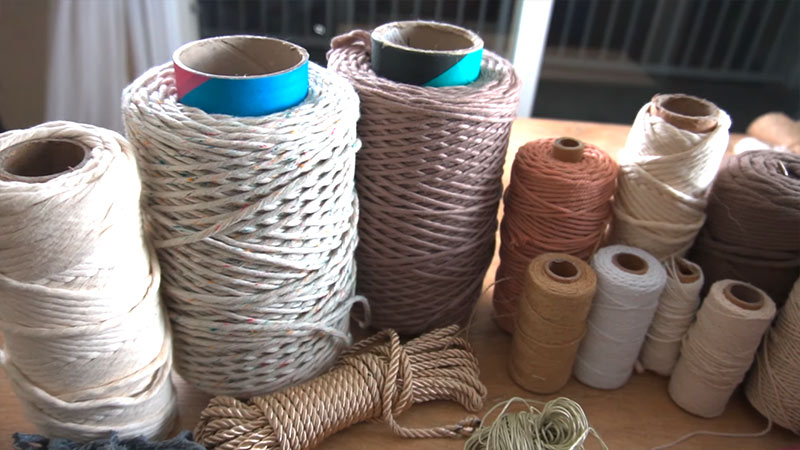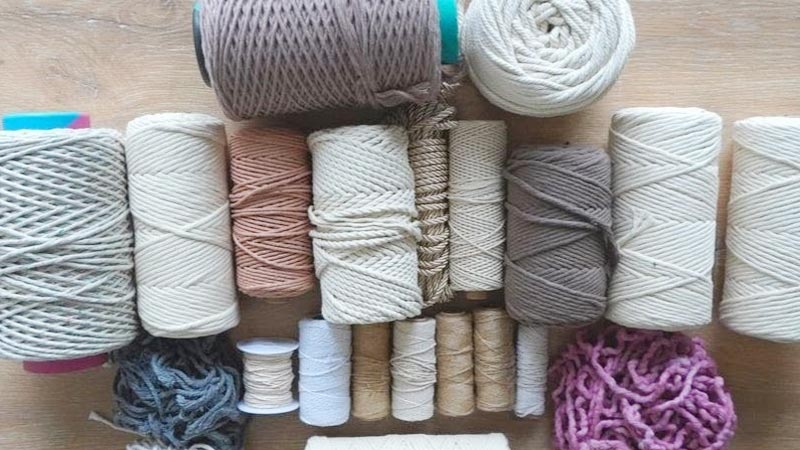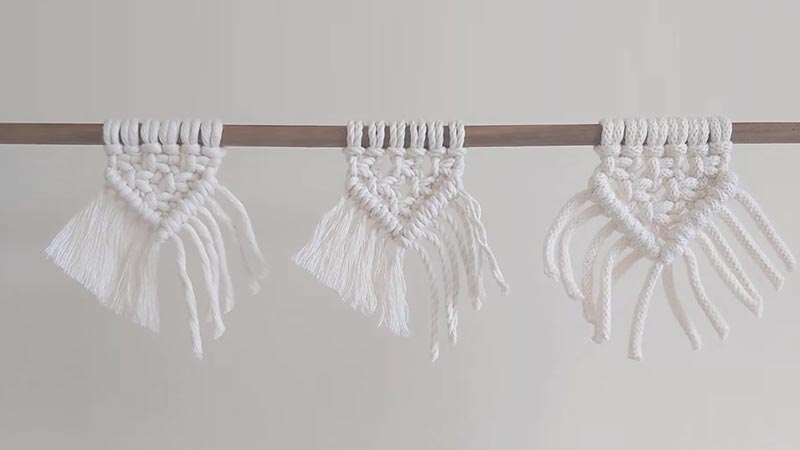Selecting the right thread is a fundamental decision when delving into the world of macrame. The thread you choose can profoundly affect the outcome of your creative endeavor, from the texture and appearance of your project to its overall durability.
In this exploration of the best threads for macrame, we delve into the intricacies of twisted rope, combed rope, and braided rope, considering factors such as material, size, and texture.
Whether you’re a beginner looking for user-friendly options or an experienced macrame artist seeking to experiment with diverse threads, this guide will help you navigate the vast array of choices.
Discover how your thread selection can transform your macrame visions into tangible, textured works of art.

Which Thread Is Best For Macrame?
The best thread for macrame largely depends on the specific project you’re working on and your desired outcome.
Macrame offers a wide range of creative possibilities, and the choice of thread can significantly influence the final appearance, texture, and durability of your piece.
Here are some common thread options for macrame:
Cotton Twisted Rope
Cotton twisted rope is a popular choice for many macrame projects. It is soft, easy to work with, and comes in various thicknesses.
Cotton twisted rope is versatile and suitable for a wide range of projects, including wall hangings, plant hangers, and decorative items.
It’s often recommended for beginners due to its manageability.
Natural Fibers (Hemp, Jute, etc.)
If you’re looking for a rustic and earthy look in your macrame, natural fibers like hemp or jute are excellent choices. They offer a unique texture and are commonly used in boho and rustic designs. Natural fibers are durable and provide a distinct character to your work.
Braided Rope
Braided rope is a durable option, often made from materials like cotton, rayon, or polyester. It has a smooth surface and is resistant to fraying and unraveling. This makes it suitable for larger and sturdier macrame items like rugs, curtains, or outdoor decor.
Synthetic Cord (Nylon, Polypropylene)
Synthetic cords, such as nylon or polypropylene, are chosen for their durability and weather resistance. They are ideal for outdoor macrame projects like plant hangers, as they can withstand exposure to the elements.
Combed Rope
The combed rope is created by twisting a single strand of threads together, resulting in a smoother and fluffier texture compared to twisted rope. It’s often used for creating decorative elements in macrame, such as fringes or feathers.
Macrame Yarn
Specialized macrame yarn is designed specifically for macrame projects. It comes in various colors and thicknesses, offering a wide range of possibilities for your creative endeavors.
What Size of Thread is Ideal for Macrame Projects?

The ideal thread size for macrame projects depends on several factors, including the type of project, your design goals, and personal preferences.
Here are some guidelines to help you choose the right thread size for your macrame endeavors:
3 mm Thread
This is the most common and versatile size for macrame projects. It works well for a wide range of items, including wall hangings, plant hangers, bags, and cushions. With 3 mm thread, you can create intricate knots and patterns without making your work too bulky.
2 mm or 1.5 mm Thread
These smaller thread sizes are perfect for projects that require more delicate and detailed designs. They are well-suited for making jewelry, keychains, coasters, or small decorative items.
Keep in mind that using smaller threads will require more knots and additional time to complete your project.
4 mm or 5 mm Thread
These larger thread sizes are ideal for creating larger and less intricate designs. They work well for items like rugs, baskets, curtains, or extra-large wall hangings. Using bigger threads allows you to finish your project more quickly and gives it a chunkier, textured appearance.
How to Choose the Right Thread for A Macrame Project?

Choosing the right thread for your macrame project is crucial as it can greatly affect the outcome of your creation.
Here’s a comprehensive guide on how to choose the right thread for your macrame project:
Define Your Macrame Project
Start by defining the type of macrame project you plan to undertake. Whether it’s a wall hanging, plant hanger, jewelry, or a larger decorative item, understanding the project’s nature is the first step in selecting the right thread.
Consider the Material
Macrame threads come in various materials, each with unique qualities. Cotton threads are soft and easy to work with, while synthetic fibers offer durability. Consider the material that best suits your project’s requirements and aligns with your aesthetic preferences.
Evaluate Texture and Appearance
Consider the texture and appearance you want to achieve in your macrame project. Different threads create different textures, from smooth and polished to rustic and textured. Ensure the thread’s texture complements your project’s style.
Determine the Size/Diameter
The size or diameter of the thread is a critical factor in achieving the desired look. Smaller threads (e.g., 1.5mm-3mm) are perfect for intricate, delicate work, while larger threads (e.g., 4mm-5mm) create bulkier, textured pieces.
Consider Durability
Think about the thread’s durability, especially if your project will be exposed to outdoor elements or frequent use. Some threads are more resistant to fraying and wear, making them ideal for long-lasting or outdoor projects.
Reflect on Ease of Use
If you’re a beginner or prefer a user-friendly thread, consider starting with one that is easy to work with. Cotton twisted rope, for example, is often recommended for its manageability and flexibility.
Explore Color Options
The color of your thread can significantly impact the final appearance of your macrame project. Choose a color that complements your project’s design and aligns with your personal preferences, allowing you to achieve your desired aesthetic.
Trust Your Personal Preferences
Ultimately, the choice of thread should align with your personal preferences and the vision you have for your macrame project. What appeals to you aesthetically and the textures you enjoy are essential considerations.
Experiment and Learn
Don’t be afraid to experiment with different threads and materials. Macrame is a creative art form, and discovering what works best for your unique project through experimentation can be an exciting and rewarding part of the creative process.
FAQs
What is the best thread for beginners in macrame?
For beginners in macrame, 3 mm cotton twisted rope is often recommended as it’s easy to work with, versatile, and suitable for various projects.
Can I mix different threads in a single macrame project?
Yes, it’s possible to mix different threads to achieve unique textures and appearances in your macrame projects. Experimentation can lead to creative and interesting results.
How does thread material affect the outcome of a macrame project?
Thread material profoundly influences a macrame project’s appearance, texture, and durability. Cotton provides softness, while synthetic fibers offer durability and natural fibers contribute to a rustic aesthetic.
Are there threads suitable for eco-friendly macrame projects?
Yes, eco-friendly macrame projects benefit from threads made of sustainable and natural materials like organic cotton, jute, or bamboo, reducing environmental impact.
Are there threads specifically suited for macrame plant hangers?
Yes, threads like synthetic cord, nylon, and durable cotton are well-suited for macrame plant hangers, providing strength and weather resistance.
To Recap
The world of macrame is a tapestry of creativity, and the thread you choose is your vital artistic instrument. Our journey through the labyrinth of macrame threads has unveiled the nuances of twisted, combed, and braided ropes, each with its unique character.
The selection of the ideal thread is a deeply personal choice, influenced by your project’s demands and your artistic vision. As you weave through the possibilities, remember that macrame is not just an art form; it’s a tactile expression of your imagination.
So, let your creative journey be guided by the threads that resonate with your vision, and embrace the art of macrame as a captivating blend of texture, form, and style. Your macrame masterpiece awaits one knot at a time.
Leave a Reply